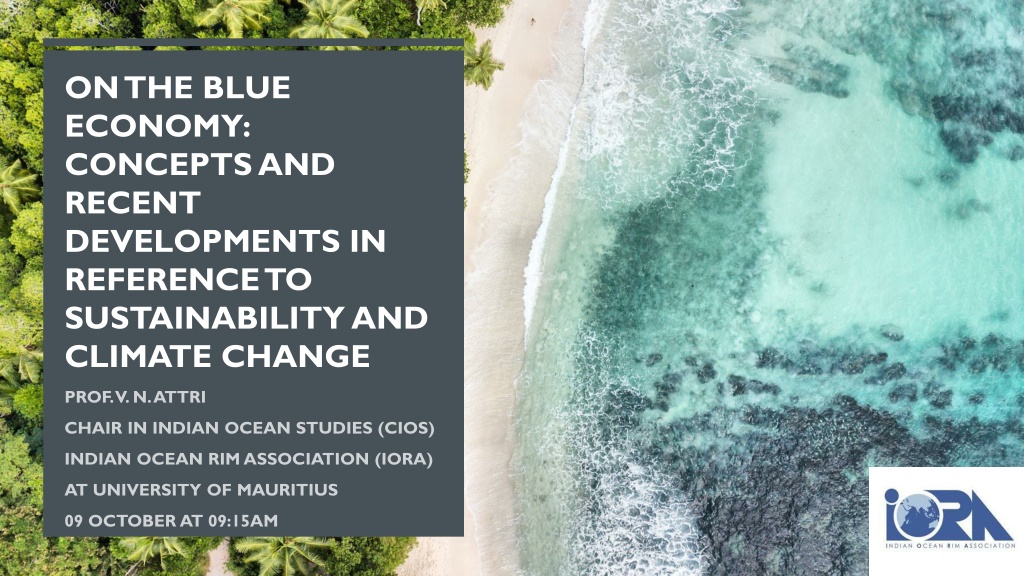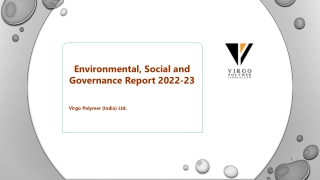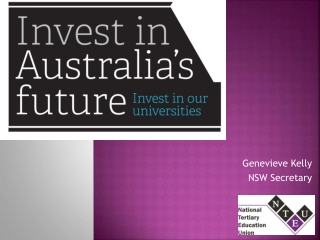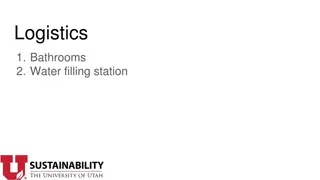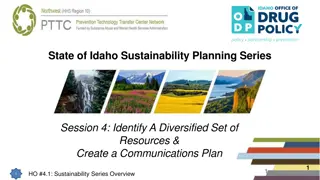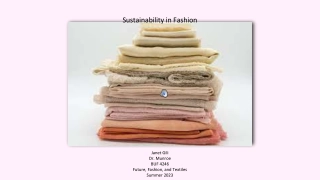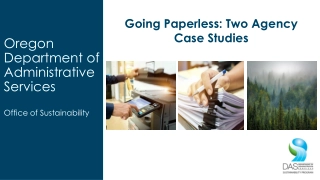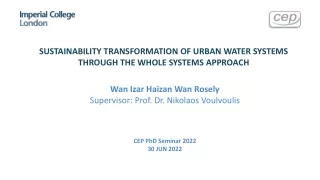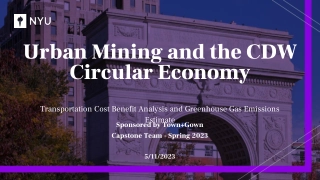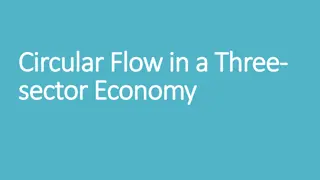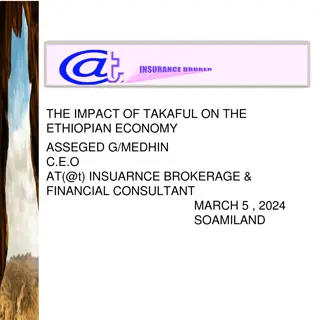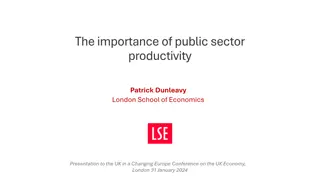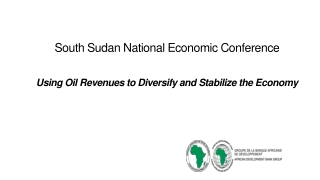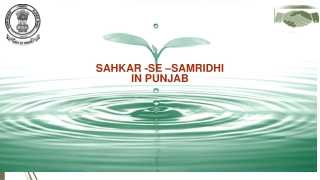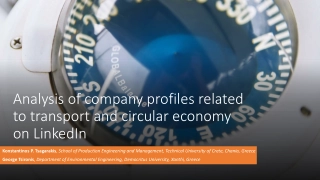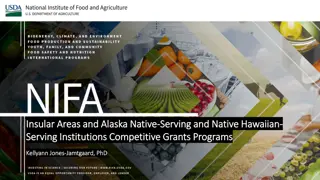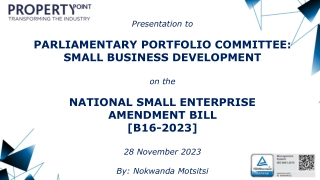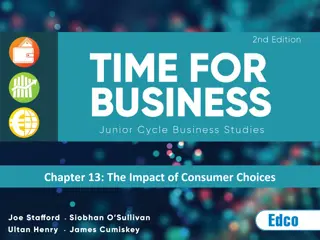Sustainability and the Blue Economy Concepts
The intertwining concepts of sustainability and the blue economy, focusing on historical developments, environmental protection events, and the emergence of sustainability science. Discover the pillars supporting a sustainable blue economy and pathways for inclusive development.
Download Presentation
Please find below an Image/Link to download the presentation.
The content on the website is provided AS IS for your information and personal use only. It may not be sold, licensed, or shared on other websites without obtaining consent from the author. Download presentation by click this link. If you encounter any issues during the download, it is possible that the publisher has removed the file from their server.
Presentation Transcript
ON THE BLUE ECONOMY: CONCEPTS AND RECENT DEVELOPMENTS IN REFERENCE TO SUSTAINABILITY AND CLIMATE CHANGE
Background to the Blue Economy Definitions of the Blue Economy Pillars of the Blue Economy TABLE OF CONTENTS Blue Economy in Mauritius Blue Economy in some IORA Member States Pathways for a Sustainable and Inclusive Blue Economy Major Conclusions Policy Recommendations
The conservation as well as Sustainable Development occurred in the 1970s- 80s. rise of consciousness around environmental protection and Key events were held which brought to the forefront the critical issues about the loss of biodiversity, depletion of marine and land ecosystems and the need for urgent actions such as Intergovernmental Conference for Rational Use and Conservation of the Biosphere (UNESCO) in 1968 with early discussions on the concept of ecologically sustainable development; UN Conference on the Human Environment and UNEP is held in 1972 in Stockholm leads to the establishment of many national environmental protection agencies and the United Nations Environment Programme (UNEP); in 1975, the Convention on International Trade in Endangered Species of Flora and Fauna (CITES) comes into force; UN Conference on Desertification in 1977 RISE OF ENVIRONMENTALISM & SUSTAINABILITY All these led to the publication in 1987 of the report entitled Our Common Future (Brundtland Report), a report of the World Commission on Environment and Development, weaves together social, economic,cultural and environmental issues and global solutions. popularizes the term sustainable development is development that meets the needs of the present without compromising the ability of future generations to meet their own needs. It development. Sustainable
Sustainability means the ability to be sustained; the quality of not being harmful to the environment or depletion of natural resources- supporting long-term ecological balance. It is indeed the ability to endure . It is central to the idea of Sustainable Development. Sustainability Science emerged in 21stcentury as a new academic discipline. It (Sustainability Science) provides a critical framework for Sustainability. Sustainability measurement provides the evidence- based quantitative data Sustainability governance. problem-driven and focusing on: Knowledge Coordination of data approaches. WHAT IS SUSTAINABILITY? needed In nutshell, it is a interdisciplinary structuring and, Interdisciplinary to guide subject, issues, of
SUSTAINABILITY The Sustainability Science and the concept of Sustainability which has its roots in Sustainable Development and Environmental protection, is increasingly being recognized at global, regional, national and local levels, and in IORA, as a central and fundamental principle of Sustainable Blue Economy- including Circular Economy which is a part of Blue Economy. That rightly implies the integration of the Blue Economy with land-locked states- the oceans belong to all,and their productivity is enhanced through the adoption of Sustainability. Sustainability principle happens to be central to the Ocean Economy ; Blue Growth ; Blue Economy , even if it has different meaning for different people. Sustainability is growing far beyond individual products and is being extended to encompass the entire product life cycle- emanating from the oceans, seas and lakes and so on. The sustainability approach is comprehensive and being extended to in nature including production, distribution, consumption and disposal of products. It also intends to solve the problem of plastic pollution and providing an effective and reliable business model of waste management in the Blue Economy.
THE BLUE ECONOMY The concept of Blue Economy came into prominence with the publication of Gunter Pauli s book entitled The Blue Economy:10 years 100 innovations 100 million jobs , Gunter Pauli (April 2010) Gunter Pauli:the blue economy 2.0 (2014) 1. Gunter Pauli:the blue economy 3.0 (2017) 2. Gunter Pauli: let us be as intelligent as nature (fall 2017) 3. Gunter Pauli: the transformation of Argentinian economy: presenting 10 innovative sectors in the economy (spring 2018) 4. It is a comprehensive term including Ocean Economy ,environment and sustainability,and the best way to provide basic human needs- potable, water, food, jobs and habitable shelter. It focuses on creating 100 million jobs through 100 innovations within 10 years period. The concept focuses on the philosophy of resourcefulness; asserting that a blue economy model will shift society from scarcity to abundance with what is locally available
The Blue Economy paradigm constitutes a sustainable development developing countries addressing equity in access to,development of and the sharing of benefits from marine resources; offering scope for re-investment development and the alleviation of crippling national debt burdens. framework for THE UNITED NATIONS, 2012 in human
Blue Economy is a marine-based economic development that leads to improved human wellbeing and social equity, while significantly reducing environmental risks and ecological scarcities THE WORLD BANK, 2014
A sustainable ocean economy, where economic activity is in balance with the long-term capacity of ocean ecosystems to support this activity and remain resilient and healthy THE ECONOMIST INTELLIGENCE UNIT 2015
The new emerging development paradigm of the Blue Economy which is inclusive of the Ocean Economy, Green Economy, Coastal Economy and Marine Economy has a great potential for higher and faster GDP growth scale in the Indian Ocean Region (IOR). PROF. V. N. ATTRI, 2016
The Blue Economy concept seeks to promote economic growth, social inclusion, and the preservation or improvement of livelihoods while at the same time ensuring environmental sustainability of the oceans and coastal areas. At its core it refers to the decoupling of socioeconomic development through oceans-related sectors and activities from environmental and ecosystems degradation. It draws from scientific findings that ocean resources are limited and that the health of the oceans has drastically declined due to anthropogenic activities. THE WORLD BANK, 2017
Excerpt from the Nairobi Statement of Intent on Advancing Sustainable Blue Economy A sustainable blue economy builds on unlocking the possibilities of the oceans, seas, lakes and other water resources through investments that participation of all relevant people while protecting the resources for present and future generation and ecosystem resilience. full economic involve effective Sustainable Blue Economy Conference Nairobi, Kenya 26-28 November 2018
The theoretical system of new emerging interdisciplinary science of Blue Economy which focuses on Sustainability as one of its core principle; linked with climate change and accelerated technological change is the mix of natural sciences as well as social sciences which help in making the Blue Economy inclusive by focusing on economics, management, sociology and other relevant social sciences. SUSTAINABLE PROF. V. N. ATTRI, 2019 CONFERENCE, 2018
Sustainable Blue Economy represents an economic philosophy focussing on sustainable use of oceans, seas and lakes in such a way that the health of the oceans are in intact as relationship between the increasing size of human economic activities in the ocean as a development space and the health of the oceans. Sustainability is the hard core of Blue Economy. sustainable Blue Economy is to be linked with climate change, accelerated technological change and the measurement of the natural capital so as to optimise the oceanic and marine resources to achieve UN Sustainable Development Goals as well as inclusive and sustainable development; leading to decent employment to the youth-including women empowerment. there is an inverse Prof. V. N. Attri, 2019 Further, the
ESTABLISHED AND EMERGING INDUSTRIES UNDER BLUE ECONOMY Established Capture Fisheries Seafood Processing Emerging Marine aquaculture Deep-and-ultra-deep water oil and gas Shipping Ports Shipbuilding and Repair Offshore oil and gas (shallow water) Maritime safety and surveillance Offshore wind energy Ocean renewable energy Marine and seabed mining Marine manufacturing and construction Maritime and coastal tourism Marine biotechnology High-tech marine products and services Marine business services Marine R&D and education Dredging Other
THE PILLARS OF BLUE ECONOMY
Mauritius is very active in the implementation of Ocean Economy since 2014. Mauritius has an Exclusive Economic Zone of 2.3 million square Kilometres. The Ocean Economy represents over 10.5 % of the national GDP of Mauritius. It provides direct employment estimated tourism. Three established sectors: coastal tourism, seaport related activities and fishing and seafood- contribute to 90% of the GDP contribution for the Ocean Economy. The Government ambitions to double the contribution of the Ocean Economy to GDP with a strategy geared towards Consolidation of established sector; Fostering the development of emerging sectors (Fishing and seafood; Aquaculture; Maritime services; Marine commerce) and Nurturing nascent sectors (Coastal tourism; Seaport related activities; Marine biotechnology; Offshore oil and gas; Marine renewable energy) Key Investment opportunities for the ocean economy includes: Fishing, seafood processing & aquaculture; Seabed exploration for hydrocarbons and minerals; Marine Services;Ocean Knowledge;Deep OceanWaterApplications (DOWA) over 20,000 excluding coastal
THE STRUCTURE OF OCEAN-RELATED INDUSTRIES IN MAURITIUS AS REFLECTED IN ITS MEDIUM TERM STRATEGY 1. Established industries/sectors: Coastal tourism Seaport related activities Fishing and seafood 2. Emerging industries/sectors: Aquaculture Maritime services Marine commerce 3. Nurturing nascent/emerging industries/ sectors. Marine biotechnology Offshore oil and gas Marine renewable energy The Roadmap (2013) sets a target of doubling the OE s share of GDP over a 12-year time horizon (2013 2025), creating some 35,000 jobs in the process. At present, the contribution of Ocean Economy to GDP is 10.5 % and direct employment contribution is 20,000
MAURITIUS Key Investment opportunities for the ocean economy includes: i)Fishing, seafood processing & aquaculture ii) Seabed exploration for hydrocarbons and minerals iii) Marine Services iv) Ocean Knowledge v) Deep Ocean Water Applications (DOWA) The Budget of the Ministry of Finance and Economic Development 2018-19 (pp. 16-17) emphasizes the Blue Economy of Mauritius as the next venue for the import substitution in strategy and the export growth in the medium and long term by fully tapping the economic possibilities of oceans. setting up an Ocean Economy Unit with the responsibility of preparing a National Ocean Policy Paper; boost up research capacity on the ocean economy; Merge the Mauritius Oceanography Institute and the Albion Fisheries Research Centre into one single institution; An Ocean Observatory e-platform to support the Marine Spatial Planning Initiative of Mauritius; A geotechnical study will be conducted in the extended continental shelf management area of the Mascarene region to explore its potential; A Group Life Insurance Scheme for registered fishermen to cover any accidents and losses at sea; Increase the availability of fish locally and in line with our import substitution strategy, we will allow foreign industrial fishing companies to fish in our shallow water banks provided they sell all their catch on the local market; and Introduce a grant of 60 percent of the cost of acquisition of outboard engines and fishing nets, by fishermen cooperatives, up to a maximum of Rs 60,000. Furthermore, all registered fishermen will be provided with a free ice box. 1. 2. 3. 4. 5. 6. 7.
MAURITIUS BUDGETARY MEASURES 2019-2020 The Ocean Economy 94. I will now elaborate on our measures to enhance productive capacity in the Ocean Economy. 95. I am pleased to announce that the daily rate of bad weather allowance for fishermen will be increased from Rs 310 to Rs 340. 96. An online and physical fish auction market will be set up to act as an interface between local fishermen, fishing companies and buyers both local and international. 97. To consolidate and diversify our fisheries and seafood industry, a stock assessment will be conducted to better manage and protect species such as lobsters, squid and other small commercial pelagic fish. 98. The bunkering sector is a promising new growth pole in our ocean economy that must be encouraged. I am, therefore, announcing a series of measures to give a boost to this emerging sector. 99. First, a four year tax holiday will be granted on income derived from bunkering of low Sulphur Heavy Fuel Oil. 100. Second, existing storage facilities will be refurbished to cater for low Sulphur Heavy Fuel Oil. 101. Third, the Mauritius PortsAuthority will allow ship-to-ship bunkering.
MAURITIUS BUDGETARY MEASURES 2019-2020 Transforming our Port - Expanding its Role & Boosting its Competitiveness 168. Concerning the port, new investments are being made to expand its capacity, boost productivity and competitiveness. 169.The Mauritius Ports Authority (MPA) will,with the participation of the private sector,invest some Rs 12 billion to construct a breakwater to reduce downtime at the port during bad weather conditions. 170. The MPA is also investing some Rs 2.2 billion in another breakwater at Fort William to allow for the safe mooring of some 120 ocean-going fishing vessels thus creating a fully functional fishing port. 171. The navigational channel will be dredged further to a depth of 18 metres to make Port Louis the deepest port in the region. 172.The dredged materials will be used to reclaim some 60 hectares of land to create an Island Terminal of containers that will more than double the stacking capacity. 173. To increase crane productivity at the port, the Cargo Handling Corporation is acquiring one additional Ship-to-Shore crane along with associated equipment at a cost of Rs 750 million.
Within the large marine ecosystem,Bangladesh has a coastline approximately 710 kilometers long measured in a line from its westernmost to easternmost points. As in past descriptions by the Government of Bangladesh (Alam 2014), the country s ocean economy is characterized here as comprised of twenty-six industries and services, defined in order to align with ISIC categories and data availability. These industries and services reach across seven sectors: living resources, minerals, energy, transport and trade, tourism and recreation,carbon sequestration,and coastal protection Following the resolution of its maritime boundaries in 2014, the Government of Bangladesh stated its interest in pursuing the blue economy concept as part of the country s growth strategy In 2015, the Prime Minister emphasized cooperation with India in development of the blue economy (Ministry of External Affairs 2015), and the two governments signed a memorandum of understanding to promote the effort Bangladesh s Seventh Five Year Plan (FYP) emphasizes that growth in the country s ocean economy is contingent upon the status of ocean ecosystems and natural capital, and suggests that while there are some prospects for oil and gas resources, the potential is most promising for marine fishing,marine transportation and coastal and marine tourism.
AUSTRALIA By 2025, Australia s marine industries will contribute around $100 billion each year to our economy, with our oceans and coasts providing a further $25 billion worth of ecosystem services, such as carbon dioxide absorption, nutrient cycling and coastal protection. This marine economy is projected to grow three times faster than Australia s gross domestic product over the next decade,more than doubling its 2012 contribution of $47.2 billion.* To achieve this, the marine science community, government and industry must undertake a coordinated, collaborative and dedicated national effort.We need to build and share critical marine data,undertake multidisciplinary research,and create the technology,tools and innovations that will drive economic development, environmental management and cultural stewardship of our marine estate for the next decade. InAustralia,the major ocean industries are: Fisheries and Seafood Refining of Petroleum from Offshore sources Shipbuilding Shipping MarineTourism* *National https://www.aims.gov.au/documents/30301/2094401/NMSP_FINAL_Aug2015.pdf/22bff822-097f-4d6b-8c68-c53f791cd892 Marine Science: Plan Driving the development of Australia s blue economy 2015 2025,p. 7, 38 Accessed on * Wang, (2016), The Blue Economy in China's Ocean Economy Statistics, Centre for Blue Economy, p. 10 Accessed on https://cbe.miis.edu/cgi/viewcontent.cgi?article=1055&context=joce
SOUTH AFRICA In October 2014 initiated Operation Phakisa a maritime project aimed specifically at unlocking and developing Blue Economy. The objective is to promote economic growth and jobs in the country s Blue Economy. It (Phakisa) has four priority sectors as new growth areas: 1. Maritime Transport and Manufacturing Activities such as coastal shipping, trans- shipment, boat buildings, repair and refurbishment 2. Offshore oil and gas exploitation 3. Aquaculture 4. Marine protection services and ocean governance.* This was later expanded to six with the inclusion of Small Harbours Development and Coastal and Marine Tourism. Two cross-cutting and enabling areas were also identified to highlight the education and vocational skills and capacity gaps that hinder efforts to grow an oceans economy in the other labs. * Attri, V.N. (2016), An Emerging New Development Paradigm of the Blue Economy in IORA; A Policy Framework for the Future, p.9, Accessed online on < http://www.iora.int/media/23839/the-blue-economy-and-iora-2016.pdf>
INDIA The Niti Aayog initiated a consultation process for integration defense and internal security with a 15 year vision. To help increase Africa s maritime capabilities through sgar-mala . Portrayed as the most promising plan, the Sagarmala project, claims to be based on four strategic principles, namely, optimizing multi-modal transport towards reducing the cost of domestic cargo; minimizing the time and cost of export-import cargo logistics ; lowering cost for bulk industries by locating them closer to the coast; and finally improving export competitiveness which will require locating discrete manufacturing clusters near ports or agglomeration economies. The other important developmental benefits linked to the project are in terms of creation of new ports,port connectivity,port-led industrialization and harnessing the potential of coastal communities. India s status as a Maritime Nation with a long Coast line and the potential to become a significant Blue Economy. Jointly promote Blue Economy in collaboration with Mauritius, Seychelles, Sri-Lanka and Maldives (Likely to be IORA Member,focusing on environment and ecology). Maritime development in terms of domestic and international capacity building: coastal area development, port infrastructure buildings, connectivity and see-bed capacities, see- air transportation,fisheries,marine sciences,renewable energy and hydrography.
Identifying the priorities of each country and the availability of resources in the Exclusive Economic Zone (EEZ) focussing on environmental/ecosystem assessments and detailed sector-specific assessments with integrated environmental social and economic components (e.g fisheries and aquaculture,tourism etc.) Measuring the contribution of Blue Economy by evolving a standardised accounting framework grounded in System of Environment-Economic Accounting (SEEA) in accordance with the System of National Accounts (SNA) and Framework for the Development of Environment Statistics (FDES) Creating a natural capital accounting framework for natural capital applying the methods of composite indices;indices focusing on overconsumption;and monetary or physical indicators The implementation of Blue Economy requires good governance and better coordination among different ministries of the government, therefore, setting up coordination ministry/centre seems to be a importance condition for the success of the Blue Economy. A robust maritime connectivity enhances productivity, augment trade, reduce logistical costs and bolster economic development.Maritime connectivity includes efficient and competitive maritime transportation, capacity building in shipping and transport and hence ensuring a maritime connectivity is must for implementing the sustainable Blue Economy in the Indian Ocean Region (IOR) cross-sectoral Blue Economy assessments;
The national ocean policy ensures protection, maintenance, and restoration of the health of the ocean, seas, lakes and coasts, therefore, it is prerequisite to frame a National Ocean Policy on the pattern of countries such as Australia,Brazil,Canada,China,Colombia,Japan,Norway,Portugal,Russian Federation,UK, USA. Very few countries in IORA have their own National Ocean Policy,therefore,it is recommended that the Member States of IORA may initiate the process of evolving a National Ocean Policy in order to reap the ocean resources optimally and sustainably. The Marine Spatial Planning (MSP) is one of the seven enablers of the Blue Economy and hence it needs to be started in all the Member States of IORA.It is encouraging that most of the Member States have already initiated this process as it is leads to better utilization of ocean resources in the Exclusive Economic Zone (EEZ) of the respective countries. The next important step is to identify the commonalities in relation to the traditional and emerging sectors of Blue Economy in IORA. It seems that fisheries and aquaculture as well as tourism especially the coastal and maritime tourism which implies land-based and sea-based activities such as swimming, surfing, sun bathing, boating, yachting, cruising, nautical sports etc, have high degree of commonalities among the Member States of IORA which makes the case for having a common fisheries and aquaculture as well as coastal and maritime tourism policy. IORA is an organisation with diverse levels of development as well as sub-regions- Australasia, Southeast Asia,South Asia,West Asia and Eastern & Southern Africa,therefore in order to ensure regional flexibility in the implementation of Blue Economy, sub-regional approach along with the comprehensive IORA approach needs to be adopted.
The potential of the Blue Economy depends on extraction and use of marine and non-living resources, use of renewable, non-exhaustible, natural forces (Blue Energy); commerce and trade in and around the oceans and those activities that contribute to the economy such as carbon sequestration, coastal protection, waste disposal and biodiversity. We need to break with business as usual approach for the implementation of the Blue Economy, and think differently in terms of Sustainability and new technologies. New thinking tools of international finance,Marine Spatial Planning (MSP) and Natural Capital Accounting as well as Blue Bonds (Seychelles experience) and Indonesian project of waste and water treatment etc.need to be emulated. The Bangladesh s initiative of identifying 26 sectors of the Blue Economy such as shipping, coastal shipping, seaports, passenger ferry services, inland waterway transports, shipbuilding, ship recycling industries, fishery, aquaculture, coastal aquaculture and marine culture, etc. is an important step in understanding and implementing the Blue Economy in Indian Ocean Region (IOR).
We need to recognise the major ocean challenges in terms of overfishing of fish stocks, climate change, ocean acidification, pollution and marine litter and loss of biodiversity which is a great potential risk for the ocean health as well as human health through global food supply chain. Over the last five years, IORA has created a robust and responsive Blue Economy implementation mechanism which needs to be strengthened through collaboration and cooperation among the Member States and Dialogue Partners of IORA. A special mechanism of collaboration and cooperation with international organizations and UN agencies in reference to financial requirements of implementing the Blue Economy needs to be created for dealing with major issues and challenges related with the Blue Economy for the Least Developed Countries (LDCs) and Small Island Developing States (SIDs) in IORA.
1. IORA should aim at initiating the process of Marine Spatial Planning as well as evolving a National Ocean Policy in all the Member States so as to sustainably use the oceanic resources of the Indian Ocean Region (IOR). 2. A policy frame focusing on a balance between economic opportunities and the environmental limitations of using the ocean to generate more wealth may be worked out based on the science-based evidence approach as well ecosystem-based management approach.
